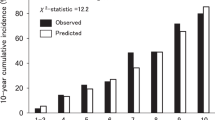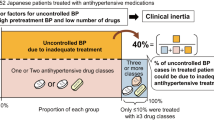Abstract
This paper aims to identify how many young adults on antihypertensive treatment have been misclassified as hypertensive. We identified subjects aged under 35 on antihypertensive treatment, from the Health Surveys for England, 1998–2004. Pretreatment systolic and diastolic blood pressures were calculated by adjusting on-treatment blood pressures for the effects of treatment. Treatment effects were derived from meta-analysis. Subjects were classified as hypertensive if pretreatment blood pressure was ⩾160/100 mm Hg, or was ⩾140/90 mm Hg in conjunction with high cardiovascular risk. We then identified the proportion of treated subjects on antihypertensive treatment who were truly eligible for treatment. From the survey data we identified 65 adults (25 men and 40 women) under 35 on diuretics, β-blockers, angiotensin converting enzyme inhibitors, calcium blockers or other antihypertensives. Average pretreatment blood pressure was 164/100 mm Hg in those eligible for treatment, and 136/79 mm Hg in those not eligible. The analysis indicated that 29.2% of adults aged 16–34 (95% confidence interval (CI): 18.6–41.8%) were truly eligible for antihypertensive treatment: 32.0% (95% CI: 14.9–53.5%) of men and 25.0% (95% CI: 12.7–41.2%) of women. A total of 73.7% (14 of 19) of subjects eligible and 41.3% (19 of 46) of subjects not eligible for treatment either had a body mass index>30 kg m−2 or kidney disease (χ2-test P=0.018). Because of biological variation in blood pressure, most young adults on treatment for hypertension have been misclassified as hypertensive. Most who have been correctly diagnosed are either clinically obese or have kidney disease.
This is a preview of subscription content, access via your institution
Access options
Subscribe to this journal
Receive 12 digital issues and online access to articles
$119.00 per year
only $9.92 per issue
Buy this article
- Purchase on Springer Link
- Instant access to full article PDF
Prices may be subject to local taxes which are calculated during checkout
Similar content being viewed by others
References
Marshall T . When measurements are misleading: modelling the effects of blood pressure misclassification in the English population. Br Med J 2004; 328: 933.
Department of Health. Health Survey for England. (http://www.data-archive.ac.uk/) [Last accessed 30th June 2006].
Law MR, Wald NJ, Morris JK, Jordan RE . Value of low dose combination treatment with blood pressure lowering drugs: analysis of 354 randomised trials. Br Med J 2003; 326: 1427–1432.
British Cardiac Society, British Hypertension Society et al.. JBS 2: Joint British Societies' guidelines on prevention of cardiovascular disease in clinical practice. Heart 2005; 91 (Suppl V): 1–52.
Levine CB, Fahrbach KR, Frame D, Connelly JE, Estok RP, Stone LR et al. Effect of amlodipine on systolic blood pressure. Clin Ther 2003; 1: 35–57.
Mokwe E, Ohmit SE, Nasser SA, Shafi T, Saunders E, Crook E et al. Determinants of blood pressure response to quinapril in black and white hypertensive patients: the Quinapril Titration Interval Management Evaluation trial. Hypertension 2004; 43: 1202–1207.
Lijnen P, Fagard R, Groeseneken D, M'Buyamba JR, Staessen J, Amery A . The hypotensive effect of captopril in hypertensive patients is age-related. Methods Find Exp Clin Pharmacol 1983; 5: 655–660.
Wright JM, Musini VJ . Blood pressure variability: lessons learned from a systematic review. Poster presentation D20, 8th International Cochrane Colloquium; October 2000; Cape Town. Further details obtained from a personal communication (e-mail) on 21st July 2003.
Marshall T . Measuring blood pressure: the importance of understanding variation. Brazilian Journal of Hypertension 2005; 12 (2): 75–82.
Little P, Barnett J, Barnsley L, Marjoram J, Fitzgerald-Barron A, Mant D . Comparison of agreement between different measures of blood pressure in primary care and daytime ambulatory blood pressure. Br Med J 2002; 325: 254–257.
Rowlands S, Moser K . Consultation rates from the General Practice Research Database. Br J Gen Pract 2002; 52: 658–660.
Schoberberger R, Janda M, Pescosta W, Sonneck G . The COMpliance praxiS survey (COMPASS): a multidimensional instrument to monitor compliance for patients on antihypertensive medication. J Hum Hypertens 2002; 16: 779–787.
Prospective studies collaboration. Age-specific relevance of usual blood pressure to vascular mortality: a meta-analysis of individual data for one million adults in 61 prospective studies. Lancet 2002; 360: 1903–1913.
Bryan S, Gill P, Greenfield S, Gutridge K, Marshall T, Birmingham Patient Preferences Group. Predictors of patients' preferences for treatments to prevent heart disease. Heart 2006; 92: 1651–1655.
Edmunds E, Beevers DG, Lip GYH . What has happened to malignant hypertension? A disease no longer vanishing. J Hum Hypertens 2000; 14: 159–161.
Zampaglione B, Pascale P, Marchisio M, Cavallo-Perin P . Hypertensive urgencies and emergencies: prevalence and clinical presentation. Hypertension 1996; 27: 144–147.
Author information
Authors and Affiliations
Corresponding author
Additional information
Contribution: Tom Marshall had the original idea. Ruth Tennant, Wayne N Harrison and Tom Marshall obtained the data, carried out the analysis and wrote the paper jointly.
Conflict of interest
None.
Appendix
Appendix
In meta-analysis, the average reduction in blood pressure was 8.8 mm Hg systolic and 4.4 mm Hg diastolic at standard dose of a thiazide (for example, bendroflumethiazide 2.5 mg). Drugs reduced blood pressure from all pretreatment levels, more so from higher levels; for a 10 mm Hg higher blood pressure, the reduction was 1.0 mm Hg systolic and 1.1 mm Hg diastolic greater.3 Average pretreatment blood pressure in the meta-analysis was 154/97 mm Hg. The effect of a standard-dose thiazide on systolic blood pressure is therefore given as 8.8+1.0 × (pretreatment systolic BP−154)/10. The effect of a standard-dose thiazide on diastolic blood pressure is therefore given as 8.8+1.1 × (pretreatment systolic BP−97)/10. Therefore, the effects of a standard-dose thiazide can be expressed as shown in Table A1.
The effects of each class of drug at half-standard dose, standard dose and high dose are shown in Table A2.
Rights and permissions
About this article
Cite this article
Marshall, T., Tennant, R. & Harrison, W. Estimating the proportion of young adults on antihypertensive treatment that have been correctly diagnosed. J Hum Hypertens 22, 96–101 (2008). https://doi.org/10.1038/sj.jhh.1002291
Received:
Revised:
Accepted:
Published:
Issue Date:
DOI: https://doi.org/10.1038/sj.jhh.1002291



